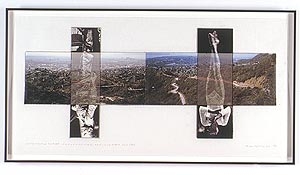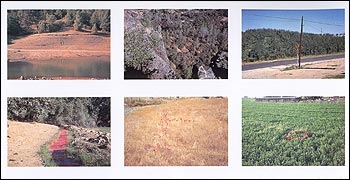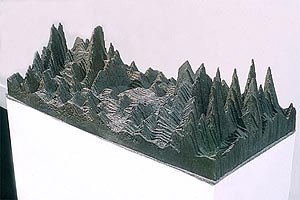
John Baldessari, Intersection Series: Two Landscapes; Two Inverted Persons (2002) archival digital prints with crayon and tape on graph paper. Collection of Brenda Potter and Michael Sandler
Feature: Reviews
Topographies
- Walter and McBean Galleries
- San Francisco Art Institute
- March 19 - May 8, 2004
Curated by Karen Moss
Walter and McBean Galleries
San Francisco Art Institute
March 19 - May 8, 2004
Pasadena Museum of California Art
July 10 - September 26
In a recent Newsweek, an advertisement displayed a truck parked askew, the front tires mounting a plateau of rock. Strange rock formations could be seen in the distance. “An American Revolution: Chevrolet Tahoe” read the copy (note that Tahoe has no relationship to the landscape depicted), continuing “Today’s word is ‘topography.’” The recent exhibition Topographies seemed to support that claim. Curator Karen Moss made a point of investigating the definition of the word. Derived etymologically from the Greek words topos (place) and graphein (to write), “topography” means “the writing of place.” Now that is a concept rich with ideas and potential. I really wanted to love this show.
Topographies collected the work of twenty-three artists, all from California. They ran the gamut from art stars to emerging ingenues and from a familiar crew from the Bay Area to a less familiar group from the South and between. It was refreshing to see a diverse range of artists at different stages of their careers. Also commendable was the combination of disciplines, from media to drawing to sculptures and painting, architectural
models and installation. This show had it all — particularly important when it could easily have bored the audience with a preponderance of maps.
On entering the gallery, the first work around the corner was Baldessari’s California Map Project, Map 1, California. In a lively play on the “writing of place,” Baldessari created a series of photographs displaying each letter from the word “California” placed in the landscape at the exact location of where it was found on a National Geographic map. The juxtaposition of the symbols with the real world begged questions of scale, illusion and representation. The work set the stage for an exhibition about the delineation of terrain particular to California, a region known for the intertwining of landscape and lifestyle. But despite the fact that all the artists are from California, this concept did not develop into a meaningful underpinning. This was but one of the many potential loci which were left hidden within the broad brush stroke of Topographies, a potential focal point which could have shaped the voice of the show.
Instead one encountered the rather anonymously “site specific” installation by Jessica Bronson, Perpetual/Perceptual. The walls of the installation were lined with a series of light sticks displaying text relating to the present level of alert system used by Homeland Security. The text was only visible out of the corner of one’s eye, which was interesting metaphorically, but I was puzzled by its relationship to a sense of topography. The catalogue may explain it rather eloquently but in place in the exhibition, it broke the rhythm.
There was a lot of wonderful work. Simon Evans’ endearing maps of the city, patched with tape, told stories of their own. Also playing literally with the “writing of place,” David Hinman translated text into three-dimensional space, creating a version of topography based on the transposition of the sounds waves into space. By taking a recording of a faked orgasm, for example, and transferring the patterns into layers of cut class, Hinman started with the narrative and created a place, inverting the normal sequence.
Charbel Ackermann drew the Bush-nomer “Axis of Evil” as a physical line across the globe, intertwining politics and place-making and acknowledging the point of view and the viewer. By bringing a pseudo-academics to the sound bite, Ackermann critiques the absurdity of the over-simplification.
Sabina Ott invented new worlds with words and undulating landscapes in what’s here is everywhere. Starting with the topographical maps of California, Ott created paintings, prints, and architectural models, which twisted and turned the original source into a land of fantasy and possibility.
The collaborative artist team Bull.miletic proclaimed You are Here. The video projection displayed the unmoving landscape of the Death Valley (again the desert as the most abstract topography). The images were taken by a camera attached to a remote control robot in a vain desire to capture the slow ponderous movement of the mysterious boulders, a movement that can only be induced by trails left in the sand. In the California tradition of Eadweard Muybridge the artists yearned to see what the eye can not. But for Bull.miletic,technology is impotent and our desire to see is incapable of overcoming our obsession with speed.
The catalogue was a strong counterpoint to the diffusion of the exhibition. In a written format, each of the many interpretations have the potential to create a separate chapter. The sequence of the pages can organize and dictate further divisions and interpretations. The very subtexts which were obfuscated in the exhibition were mutually elucidated like molecules bouncing around creating more energy from the interaction. In the end, like a loveable, bright, but distractible friend, this show was somehow too ambitious or maybe amorphous. It just couldn’t pull itself together.


